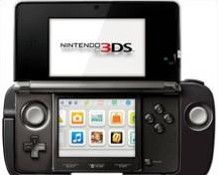
Inside the box comes the usual Nintendo manuals with instructions on how to operate the Pro, and oddly enough a wrist strap not unlike those from Wii Remotes that the guides heavily implore you to use. Using this is not a problem, as you can slide the cable through a small gap in the cradle to attach it directly to your machine, but really only those with the greasiest of paws need worry about it. Also included is one AAA battery to put into the Circle Pad Pro's back compartment, reported to last the gaming equivalent of 430 hours. Usage will put question to whether this claim is true or not, but with the device's infrared communication system, resembling that of a TV remote, it is not too hard to believe.
Your 3DS slides very easily into the Circle Pad Pro, and gives it an added bit of girth to fit easier into your palms, though you will need to remove it a considerable number of times during uses due to the ports that the cradle blocks. The headphone socket at the bottom, and charge socket at the top are still free, as is the volume slider, but the Wi-Fi switch, the SD Card slot, the stylus slot, and most importantly the Game Card slot are all blocked. Those using a dual-stick control setup probably would not require the stylus anyway, and the Pro does not work in the 3DS system's menu, so there is no harm in removing it to change games, but losing direct access to the SD port and Wi-Fi toggle might be a hindrance to some.
The Pro's considerable size does not suddenly stop the 3DS from being a portable console, but it is not really an accessory you would want to carry around with you. The curved grips at the back most definitely provide a more comfortable hold for gamers with oversized claws, but junior would probably have a hard time using this one.
As there is only one game released in Europe that supports the device at this moment, it is difficult to say how robust and effective the Circle Pad Pro truly is over time and across different game genres. Ace Combat: Assault Horizon Legacy was reported to support the accessory, but hands-on time with the European version of the game has revealed no use for it whatsoever.

The one game that does make use of the Pro, Resident Evil Revelations, does so very effectively. Allowing for a 'move and shoot' control scheme that many fans lamented the absence of in the HD-rich Resident Evil 5, the right-hand stick reacts instantaneously with the on-screen action and will make you forget that this is merely an attachment that only uses an old-fashioned radio wave to connect to the machine. The trigger buttons feel great to use too, providing more of a 'clicky' feel than the L and R triggers on the 3DS. Speaking of those, the 3DS unit's R trigger is not actually blocked off, though only those with the longest of sausage fingers can now reach it; the attachment provides a substitute R anyway so this is not a problem.
Knowledgeable long-time followers of the gaming Industry may notice that this accessory marks the first time that the analogue stick and face buttons have ended up in a side-by-side horizontal position instead of the standard vertical mapping. Switching between the two when playing a game definitely feels strange at first, and the slight distance between them may be an annoyance to smaller-palmed gamers, but it is quick and easy to adjust to.

 Sign In
Sign In 30.01.2012
30.01.2012  Game Details
Game Details
 Out now
Out now  Out now
Out now  Out now
Out now  Out now
Out now  EdEN
EdEN 
 Link to this post:
Link to this post:  Subscribe to this topic
Subscribe to this topic Features
Features





 Top
Top

